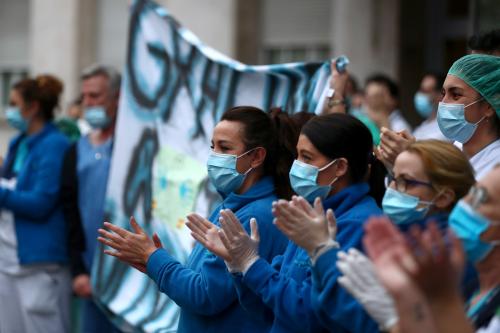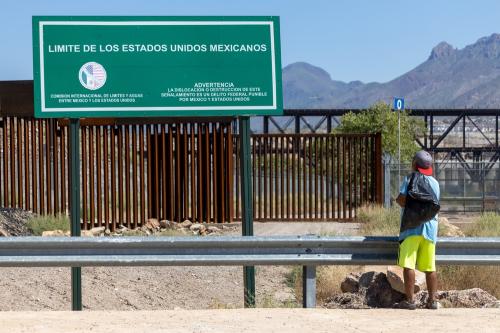One thing is clear: With COVID-19, we will all move much less, at least for a while. The virus has pretty much halted human mobility across the globe, and it looks increasingly likely that traveling across and between countries will remain restricted for the foreseeable future. From tourism to business travel and labor migration, the world will be a lot more sedentary.
This is bad news for international migration. It will only get harder to advocate more open and flexible approaches to global migration management. With trust in multilateralism at an all-time low, COVID-19 will give new ammunition to the “nationalistas”: Control borders, keep the virus—and especially the people who carry it—away from “us.” We can expect even more of an “us first” approach in politics: “our” vaccines, “our” PPE, “our” health, “‘our” borders, “our” people first.
But what about “our” jobs?
This is where the COVID-19 experience can help us look at migration through a different lens. Over the past few months, we have all learned that a range of skills, professions, and workers are especially needed in a pandemic. From doctors, nurses, and care workers to delivery drivers and shelf stackers, many of these “essential workers” come from abroad. In the U.S. for example, 30 percent of doctors and 27 percent of farm workers are foreign born. In Australia, 54 percent of doctors and 35 percent of nurses are immigrants. These key, essential workers have been celebrated as heroes during the pandemic, with weekly clappings and accolades from the highest levels of power: Upon leaving hospital after his personal encounter with the virus, U.K. Prime Minister Boris Johnson praised the two migrant nurses who cared for him—Jenny from New Zealand and Luis from Portugal.
So what would it take to turn gratitude into policy and practice change?
First of all, it is important to recognize that migrant essential workers were key to our economies and societies before the pandemic and are likely to become even more essential in the recovery to sustain our weakened economies and exhausted societies. For example, 13 percent of essential workers in the EU are immigrants (i.e., non-EU nationals). In some key occupations, however, the share is substantially higher: More than 1 in 3 domestic workers, more than 1 in 4 construction/mining workers, and 1 in 5 workers in food processing are migrants.
Figure 1. Share of immigrants among key workers, by occupation
Source: EULFS (2018) data in Fasani, F and J Mazza (2020) “Immigrant Key Workers: Their Contribution to Europe’s COVID-19 Response,” IZA Policy Paper No. 155
Note: For each occupation, the bars report the percentage of immigrants over total key workers for each occupation.
So it is not only in an emergency or crisis that doctors and nurses are “flying to the rescue.” These workers are not heroes: They are the backbone of our societies and economies. They are also the workers that help contribute between 10 and 30 percent of GDP in their countries of origin through remittances. With these remittances likely to plummet by $445 billion as a result of COVID-19, it could not be more urgent to find ways to support these essential workers. Yet these are often the very low-skilled and “disposable” migrant workers that many countries aim to keep out through increasingly stringent immigration policies.
For the sake of our collective future, this needs to change. And things are changing. Reforms are happening around the world to recognize migrant workers’ contribution to the COVID-19 response and, most importantly, to put in place measures to remove barriers and facilitate migrants’ access to labor markets, social protection, and basic services. Some of these reforms are more comprehensive than others: Portugal has temporarily granted all migrants and asylum-seekers citizenship rights; in Italy, the regularization only applies to some sectors; in the U.S., most measures are of an emergency nature and aimed at granting foreign-born health care workers temporary work permits or skills recognition. Still, these are all steps in the right direction.
The question is: How do we sustain these reforms beyond the pandemic? How do we go beyond the usual emergency/crisis narrative that so often taints migration debates and leaves us with little space for a balanced, rational, and politically viable approach to reform?
Answering this question requires a shift in thinking and practice among all of us advocating for migration reform. First, the “problem” to fix is not migration. Rather, the problem is skills, jobs, and lack of legal pathways (aka visas). Specifically, the problem is the obstacles that immigration rules pose to filling skills and labor gaps and to people being able to fulfill their aspirations, using the full range of skills and experiences they have.
These obstacles are not insignificant: Researchers at Oxford University estimate that under the new proposed U.K. Immigration Bill, 53 percent of EU-born and 42 percent of non-EU-born workers in key occupations will not meet the requirements for a post-Brexit visa.
So what would it take to make migration rules that work for people, economies, and societies?
The answer does not lie in migration policy alone. It requires context- and sector-specific reforms that are “locally led and politically smart.” It requires new coalitions between reformers with incentives to make change happen. In Italy, for example, the recent regularization reform is part of a broader COVID-19 recovery package; it was sponsored by the minister for agriculture and the minister of local development/cohesion, not the minister of internal affairs. It covers all workers in the informal economy, Italian and foreign born; it applies in specific sectors only and it is temporary in nature. In other words, like most reforms, it is partial, politically negotiated, and will require investment and incentives to be implemented.
So, it will not be easy, but we do have a unique window of opportunity to get the politics of reform right, backed by increasingly favorable public opinions and attitudes. To make the most of this, we need nothing less than an altogether different conversation—not about whether migration is good or bad, or whether borders should be open or closed. We need a conversation about the future of work, of our societies and economies adapted to COVID-19, where much-needed care workers, fruit pickers, and nurses are paid fairly and recognized for the contribution they make. No matter where they are from.
A message to the well-meaning but not always effective “migration community,” including me: This is a conversation about all us, our collective future. Not about “them.”






Commentary
Less gratitude, please. How COVID-19 reveals the need for migration reform
May 22, 2020